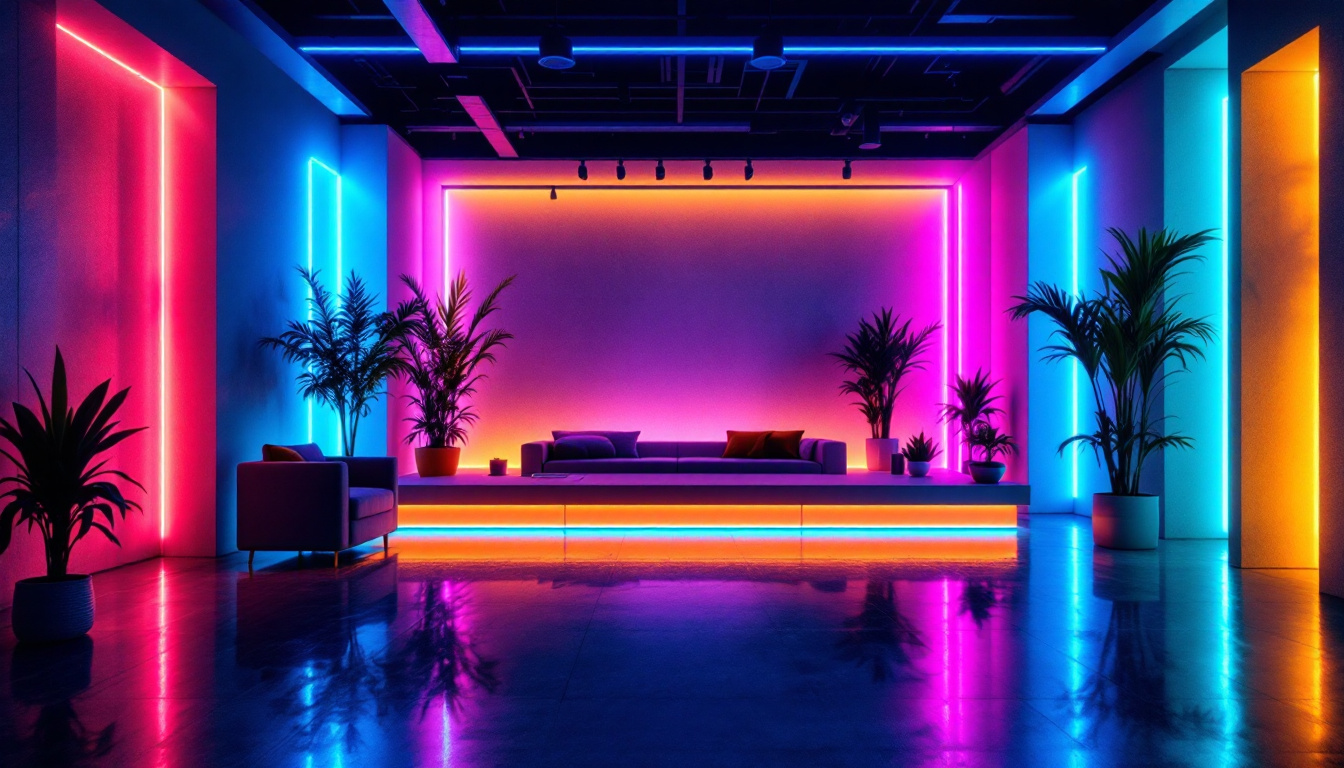
In the realm of contemporary lighting, RGB (Red, Green, Blue) technology has emerged as a transformative force, reshaping the way spaces are illuminated. This innovative approach to lighting not only enhances aesthetic appeal but also offers versatility and functionality that traditional lighting solutions often lack. For lighting contractors, understanding the role and application of RGB lighting is essential in meeting the diverse needs of clients and staying ahead in a competitive market.
RGB lighting operates on the principle of color mixing, combining red, green, and blue light to create a spectrum of colors. This technology allows for a dynamic range of hues and intensities, making it an ideal choice for various applications, from residential to commercial settings.
The fundamental concept behind RGB lighting lies in the additive color model. By varying the intensity of each color channel, a wide array of colors can be produced. For instance, combining red and green light results in yellow, while blue and green create cyan. This versatility enables lighting designers to tailor the ambiance of a space to suit specific moods or themes. Moreover, the ability to blend colors seamlessly allows for the creation of gradients and transitions that can enhance visual experiences, particularly in entertainment venues and art installations.
There are several types of RGB lighting solutions available in the market, each catering to different applications. LED strips are among the most popular options, known for their flexibility and ease of installation. These strips can be cut to size and adhered to various surfaces, allowing for creative designs. They are often used in under-cabinet lighting, accentuating architectural features, or even in outdoor settings to create vibrant pathways or garden highlights.
Another common solution is RGB bulbs, which can replace traditional incandescent or fluorescent bulbs. These smart bulbs often come with app control, enabling users to adjust colors and brightness remotely. This functionality not only enhances convenience but also allows for the synchronization of lighting with music or events, creating immersive environments for parties or gatherings. Additionally, RGB panels and fixtures provide a more integrated approach, offering sleek designs that can be incorporated into ceilings or walls. These fixtures often come with advanced features such as programmable scenes and timers, making them suitable for both residential and commercial applications, where ambiance can be adjusted according to the time of day or specific events.
The versatility of RGB lighting makes it suitable for a wide range of applications. From enhancing residential spaces to creating immersive environments in commercial settings, the possibilities are virtually limitless.
In homes, RGB lighting can dramatically alter the atmosphere of a room. Whether it’s a cozy living area or a vibrant entertainment space, the ability to change colors allows homeowners to express their personal style. Dimmers and color-changing options can set the mood for different occasions, from romantic dinners to lively gatherings.
Furthermore, RGB lighting can enhance architectural features, highlighting artwork or creating focal points. This not only adds depth to the design but also draws attention to specific elements within a space, making it feel more dynamic. For instance, a well-placed RGB strip along a staircase can create an elegant glow, guiding guests while adding a touch of sophistication. Additionally, smart home integration allows homeowners to control their lighting remotely, enabling them to customize their environment effortlessly, whether they are hosting a party or winding down after a long day.
In commercial settings, RGB lighting plays a crucial role in branding and customer experience. Retail stores often use color-changing lights to draw attention to products or create an inviting atmosphere that encourages shopping. Seasonal changes can also be reflected in the lighting, with colors adjusted to match holidays or promotional events.
Moreover, restaurants and bars utilize RGB lighting to craft unique dining experiences. The ability to shift colors can influence customer moods and enhance the overall ambiance, making establishments more memorable and enjoyable. For example, a trendy bar might use deep blues and purples for a chic, upscale vibe during the evening, while transitioning to warmer tones during brunch hours to create a more relaxed and welcoming environment. Furthermore, event spaces can leverage RGB lighting to transform their settings for weddings, corporate events, or parties, allowing for a customizable backdrop that aligns perfectly with the theme or brand identity of the occasion.
The advantages of incorporating RGB lighting into modern designs extend beyond aesthetics. These solutions offer practical benefits that can enhance both functionality and efficiency.
One of the most significant benefits of RGB lighting, particularly in LED form, is energy efficiency. Compared to traditional lighting solutions, RGB LEDs consume significantly less power, leading to reduced energy bills. This is particularly important for businesses looking to minimize operational costs while maintaining an appealing environment.
Additionally, the longevity of LED technology means that replacements are less frequent, further contributing to cost savings over time. This makes RGB lighting an attractive option for both residential and commercial applications. Furthermore, the ability to adjust the brightness and color temperature can help optimize energy usage throughout the day, allowing users to create the perfect ambiance while still being mindful of their energy consumption.
RGB lighting systems often come equipped with advanced control options, allowing users to customize their lighting experience. Smart home integration enables homeowners to adjust colors and brightness through their smartphones or voice-activated devices, providing convenience and flexibility.
For contractors, offering clients the ability to personalize their lighting solutions can be a significant selling point. Providing options for programmable scenes or schedules can enhance user satisfaction and create a more tailored experience. Additionally, the use of RGB lighting can transform spaces for various occasions, from creating a cozy atmosphere for movie nights to energizing environments for parties or events. The ability to sync lighting with music or other media further elevates the experience, making RGB lighting not just a functional element, but a dynamic part of the overall ambiance.
While RGB lighting offers numerous benefits, there are also challenges and considerations that lighting contractors must address when implementing these solutions.
One of the primary challenges is ensuring compatibility with existing electrical systems. RGB lighting systems may require specific wiring or controllers, which can complicate installation in older buildings. Contractors must assess the infrastructure and make necessary adjustments to accommodate new technology.
Additionally, proper installation is crucial for achieving the desired effect. Misalignment or incorrect placement can lead to uneven lighting or color discrepancies, which may detract from the overall design. Therefore, attention to detail during the installation process is essential.
Moreover, the integration of RGB lighting with smart home systems can introduce another layer of complexity. Many clients desire seamless control over their lighting through mobile apps or voice-activated devices, which necessitates a thorough understanding of both the lighting technology and the smart home ecosystem. Contractors must stay updated on the latest advancements in smart technology to provide clients with the most efficient and user-friendly solutions.
While the long-term savings associated with RGB lighting are appealing, the initial investment can be a barrier for some clients. Lighting contractors should be prepared to discuss the cost-benefit analysis with clients, emphasizing the energy savings and enhanced experience that RGB solutions provide.
Offering a range of options, from budget-friendly solutions to high-end systems, can help cater to diverse client needs and preferences. Educating clients about the value of RGB lighting can also facilitate better decision-making.
Additionally, contractors should consider the potential for future upgrades or expansions when discussing costs. Clients may appreciate knowing that their initial investment can be built upon over time, allowing for incremental improvements without the need for a complete overhaul. This approach not only enhances the longevity of the installation but also fosters a relationship of trust and transparency between contractors and clients, ultimately leading to more successful projects.
The landscape of RGB lighting is continually evolving, with new technologies and trends emerging that promise to enhance its application and effectiveness.
As smart home technology becomes increasingly prevalent, the integration of RGB lighting with other smart devices is expected to grow. This includes synchronization with music, movies, or even the time of day, creating immersive environments that respond to user preferences.
Contractors should stay informed about the latest advancements in smart lighting systems to offer clients cutting-edge solutions that enhance their living or working spaces.
Another trend is the focus on color quality and accuracy. As consumers become more discerning, the demand for RGB lighting that provides true-to-life colors is on the rise. Manufacturers are investing in technology that enhances color rendering and consistency, ensuring that the lighting experience meets high standards.
Lighting contractors should be aware of these advancements and consider them when recommending products to clients, ensuring that the solutions provided align with their expectations.
RGB lighting has established itself as a pivotal element in modern lighting solutions, offering unparalleled versatility and aesthetic appeal. For lighting contractors, embracing this technology not only enhances the services offered but also positions them as leaders in a rapidly evolving industry.
By understanding the intricacies of RGB lighting, its applications, benefits, and challenges, contractors can better serve their clients and create spaces that are not only functional but also visually stunning. As the industry continues to innovate, staying informed about trends and advancements will be essential for success in the competitive lighting market.
Ready to elevate your lighting solutions with the vibrant versatility of RGB technology? At LumenWholesale, we provide lighting contractors with the highest quality, spec-grade RGB lighting products at unbeatable wholesale prices. Say goodbye to local distributor markups and hello to our extensive selection that meets rigorous industry standards. With free shipping on bulk orders, you can trust that you’re getting premium lighting at the best value — without any hidden fees. Don’t compromise on quality or cost; choose LumenWholesale for a seamless blend of excellence and affordability. Wholesale Lighting at the Best Value is just a click away.

Discover the essential strategies and techniques for lighting contractors to effectively illuminate gym spaces.

Discover innovative cost-saving strategies for lighting contractors in “Light Factory.” Learn how to optimize resources, reduce expenses, and enhance project efficiency without compromising on quality.

Discover why purchasing switches and receptacles in bulk from local distributors might not be the best choice.

Discover expert tips and strategies for lighting contractors to master the installation and optimization of motion sensing security lights.